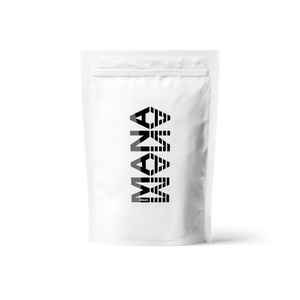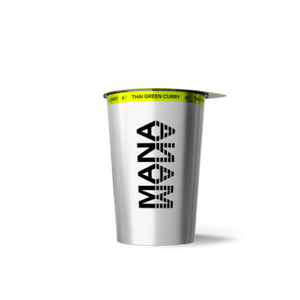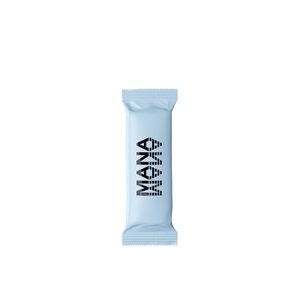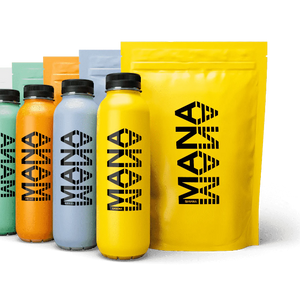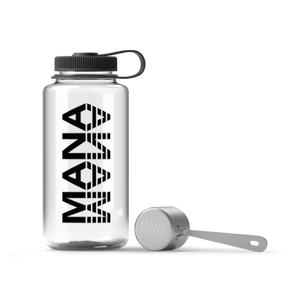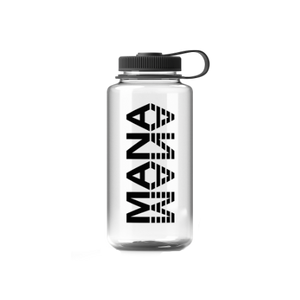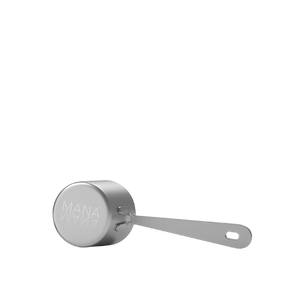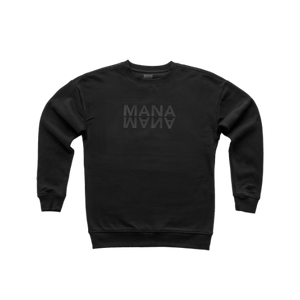Why Mana?
Everything Your Body Needs
Our complete meal solutions contain 42 essential nutrients that give you everything you need to stay healthy in the face of life's daily challenges.
Rocket Science? No.
Nutritional Science? Absolutely.
The composition of Mana is based on clinical studies conducted by the European Food Safety Authority (EFSA) and the World Health Organization (WHO), proprietary clinical studies conducted in cooperation with Charles University in Prague, and experience in clinical medicine.
Nearly every year, we update our recipe in accordance with the latest findings in science, as well as feedback from customers. We are currently serving Mark 6—the 6th incarnation of Mana since 2014. The entire Mark 6 lineup can be found here.
Latest Mark 6 Recipe
- 42 essential nutrients
- 4 new types of protein (6 total)
- 1 new type of fat (6 total)
- 5 new types of fiber (8 total)
- 38 vitamins & minerals
- New forms of 3 minerals: Mg, K, Zn
- Rich in algae omega-3 (EPA & DHA)
- Complete spectrum of amino acids
- Low glycemic index (29)
- No GMOs
An Unfair Advantage
42 Essential Nutrients
Essential nutrients are those that our bodies cannot create on their own, and which are indispensable to proper bodily function and metabolism. They must be consumed in proper amounts every day through food. Mana contains 42 essential nutrients in the perfect amounts.
Go Ahead. Flex.
6 Types of Protein
The unique combination of proteins in Mana supports the growth and regeneration of muscles. One serving of ManaPowder™ delivers 21 g while one serving of ManaDrink™ delivers 17 g. Both contain all essential amino acids in balanced proportions. This protein comes from 6 different sources: soy, peas, oats, hemp, rice, and algae.
Algae: One of Mana's Secret Weapons
6 Types of Fat
Among other things, the fats in Mana help regulate cholesterol and supply quick energy to the body and brain. Our drinks and powders contain a mixture of oils from algae (rich in EPA and DHA omega-3s), coconut, sunflower, flaxseed, canola, and oats, plus phospholipids from soy lecithin. These oils are also a source of important fat-soluble nutrients such as vitamin E, phytosterols, and lutein.
Mana delivers a beneficial 2:1 ratio of omega-6 to omega-3 fatty acids.
Go With Your Gut
8 Types of Fiber
The fiber in Mana supports the growth and function of friendly intestinal bacteria. One serving of our powder delivers 7 g while one serving of our drink delivers 4.4 g. In case of ManaPowder™, this is a mixture of oat fiber with beta-glucans, soluble chicory fiber (also known as inulin), carrot fiber, hemp fiber, pea fiber, algae fiber, acacia gum, and soy fiber. The list is the same for ManaDrink™, only it contains cellulose instead of acacia gum.
Biocatalytic Igniter. Boom.
14 Essential Vitamins
In the human body, vitamins function as biocatalysts and antioxidants. They play a role in the metabolism of protein, fat, and carbs, as well as the reabsorption of minerals.
Mana, thanks to its complete spectrum of 14 essential vitamins, is a perfectly balanced multivitamin in unconventional form. These vitamins are: vitamin A, vitamin B12 (which animal-free diets often lack), 7 other B-group vitamins, and vitamins C, D2, E, K1, and K2.
The Backbone of Being
17 Essential Minerals
Minerals are vital for optimal performance of the human body. They play a key role in metabolism, tissue construction, brain function, muscle activity, and so much more.
Our Mark 6 recipe delivers 17 essential minerals and trace elements that your body needs for optimal performance, as well as new, chelated forms of magnesium (magnesium lactate), potassium (potassium citrate), and zinc (zinc gluconate), which are even more soluble.
Mana also contains another 7 trace minerals, which occur naturally in food.
Ultimate Carbs for Braniacs
Low Glycemic Index
Thanks in part to its combination of simple and complex carbohydrates, Mana has a low glycemic index (29), which means that it causes a steady rise and fall of blood glucose levels over time, for gradual release of energy. Low-GI foods greatly reduce the risk of diseases like obesity and diabetes.

Graph: Average absolute glycemic values over time. The data is shown as the mean ± SEM; p < 0.0001 for interaction time vs. test, two-way ANOVA.
A Profile for Modern Endeavors
21st-Century Macros
Carbs, lipids, and proteins are macronutrients, i.e. nutrients which must be consumed in large amounts for proper bodily function. Of the total energy content in ManaPowder™, protein accounts for 22%, lipids account for 44%, and carbohydrates account for 34%. The ratio in ManaDrink™ is practically the same. This ratio is based on EFSA recommendations and the latest clinical studies in nutrition.
Amino Acid Profile
Amounts of amino acids in 5 servings of ManaPowder™ (per 100 g/protein)
Amounts of amino acids in the reference protein of the WHO (per 100 g/protein)
Subatomically Perfect
Designed to Enhance
Lipids from algae
Algae is good for your heart, brain, and vision. This is owing to its unsaturated DHA and EPA fatty acids, which produce beneficial effects at consumption of 250 mg per day. 5 servings of ManaPowder™ (a daily portion) supplies 1150 mg of these acids, 1105 mg of which are DHA. 6 servings of ManaDrink™ (a daily portion) supplies 1122 mg, 1080 of which are DHA.
Disaccharides from white beet
IIsomaltulose, also known as Palatinose, is a disaccharide that helps keep Mana's glycemic index low (29), thus reducing the risk of heart disease and diabetes. Foods containing isomaltulose help regulate blood glucose levels better than foods containing sugar.
8 types of fiber
ManaPowder™ contains 8 types of fiber: oat fiber with significant beta-glucan content, soluble chicory fiber (inulin), carrot fiber, hemp fiber, pea fiber, algae fiber, acacia gum, and soy fiber. The list is the same for ManaDrink™, only it contains cellulose instead of acacia gum. All of these support the growth of friendly intestinal bacteria. Oat beta-glucans also help maintain normal blood cholesterol levels.
Lipids from flaxseed
Flaxseed oil contains omega-3 fatty acids, which, among other things, protect the brain against ageing. The flaxseed oil used in Mana is both organic and cold-pressed. And thanks to special oxygen-exclusion technology, we avoid any unwanted peroxidation. Flaxseed oil contains the highest concentration of omega-3 fatty acids of all vegetable oils.
Lipids from sunflower
Sunflower oil protects skin and body tissue from oxidative stress. It contains a rich monounsaturated (MUFA)/polyunsaturated (PUFA) mixture of predominantly oleic acid (omega-9) and linoleic acid (omega-6), as well as high concentrations of vitamin E and phytosterols.
Oligosaccharides from corn
Corn helps deliver quick energy to the body and, in combination with the other ingredients in Mana, contributes to smooth digestion. In addition to being a source of pure and well-structured carbohydrates, corn gives Mana a pleasant consistency and mild sweetness.
6 types of protein
1 serving of ManaPowder™ and ManaDrink™ delivers 21 g and 17 g of protein, respectively, which comes from a balanced mix of soy, peas, oats, algae, brown rice, and hemp. When combined, these sources deliver a full, complex plant protein with a complete spectrum of amino acids that supports the growth and regeneration of muscles.
Lecithin from soy
Soy lecithin is a source of the valuable nutrient choline, which improves memory and may help fight symptoms of dementia. Thanks to its emulsifying and stabilising properties, it is an essential component of Mana.
Lipids from canola
Canola oil contributes to the maintenance of normal blood cholesterol levels. It is rich in omega-6 and omega-3 fatty acids, low in saturated fat, and high in fat-soluble vitamins and phytochemicals such as lutein and phytosterols.
Lipids from coconut
Unique among natural oils, coconut oil burns fast to deliver quick energy to your body and brain. The coconut oil used in Mana is both organic and cold-pressed; it has a pleasant aroma, a solid consistency, and is rich in saturated medium-chain fatty acids—especially lauric, myristic, caprylic, and capric acid. It contains only a small amount of highly saturated fatty acids.
